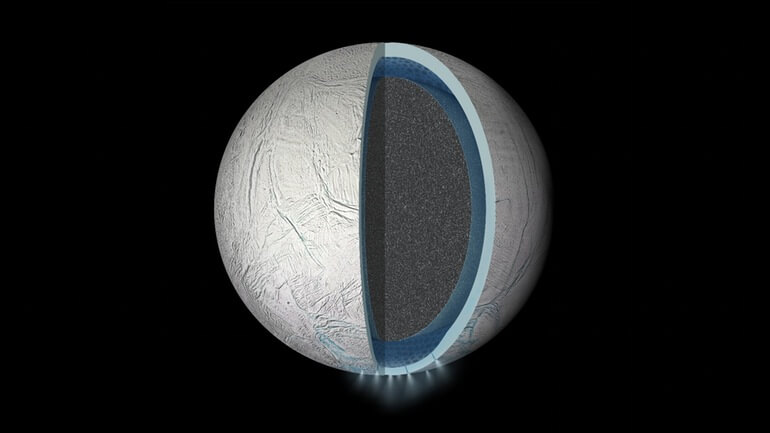- Get link
- X
- Other Apps

Scientists from NASA suggest that under the thick ice crust of one of Saturn's moons, Enceladus, may be hiding a whole world ocean. The assumption is made on the basis of multi-year analysis of images taken by the Cassini autonomous interplanetary probe, as well as indications of measurements of satellite rotations, in which some fluctuations in nature are observed, similar to those that occur during the rotation of a raw egg.
In addition, as noted by scientists, the sixth satellite of Saturn is geologically active. Serious suspicions about the presence of underground water on Enceladus, representing, perhaps, a huge lake or sea, began to arise even when Cassini recorded and photographed water vapor geysers, ice particles and simple organic molecules that were sprayed from faults at the south pole of the satellite . However, the presence of changes in the gravitational field, which are indicated by Cassini's observations, may indicate that there is much more hidden water under the thickness of Enceladus’s ice than was previously thought.
The latest discoveries of independent sources, based on the analysis of the oscillations or librations of Enceladus, measured by Cassini after he entered the Saturn system and began flying over satellites of the planet in 2004, seem to confirm the idea of having an ocean. Oscillations were measured by comparing images of satellite surface features over a period of several years. Using hundreds of such images, scientists were able to detect the presence of these vibrations.
According to NASA, these fluctuations may be the result of a slightly irregular shape of Enceladus and its elliptical orbit around Saturn. These factors lead to uneven stress, which causes Enceladus to move unevenly in its orbit, much the same way as it does with the Moon, which turns around the Earth. Nevertheless, the main question was for scientists to find the source of changes in the intensity of these fluctuations.

After creating and testing several computer models, researchers from NASA came to the conclusion that, most likely, the difference in the intensity of oscillations is due to the presence of a liquid layer between the ice crust and the solid core of the satellite. And the effect is enhanced by the rotation of the satellite.
“If the surface and the core were tightly connected, then the total mass of the core would compensate for damping these vibrations and they would be smaller,” said Matthew Tiskareno, a Cassini program specialist at the SETI Institute.
“Our observations can only indicate one thing. There is a layer of fluid between the core and the crust. ”
Scientists are now trying to figure out why Enceladus is such a geologically active satellite when it should be just a big piece of ice. One possible answer may be Saturn's tidal forces. To help solve this riddle, Cassini is planning to fall on October 28 to a height of 49 kilometers above one of the polar caps.
The article is based on materials .
- Get link
- X
- Other Apps
Comments
Post a Comment